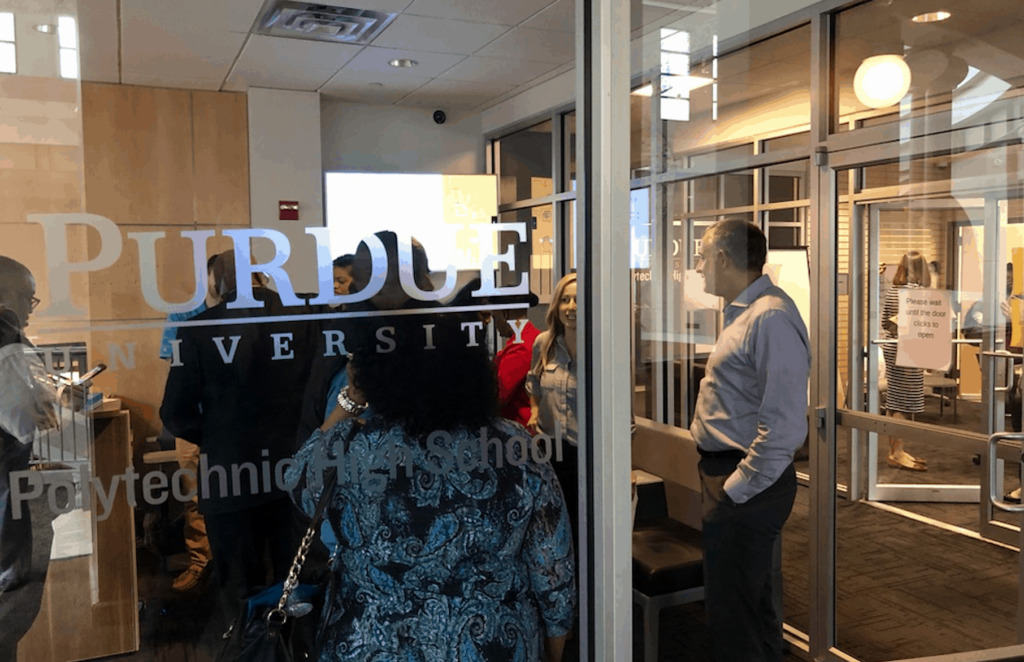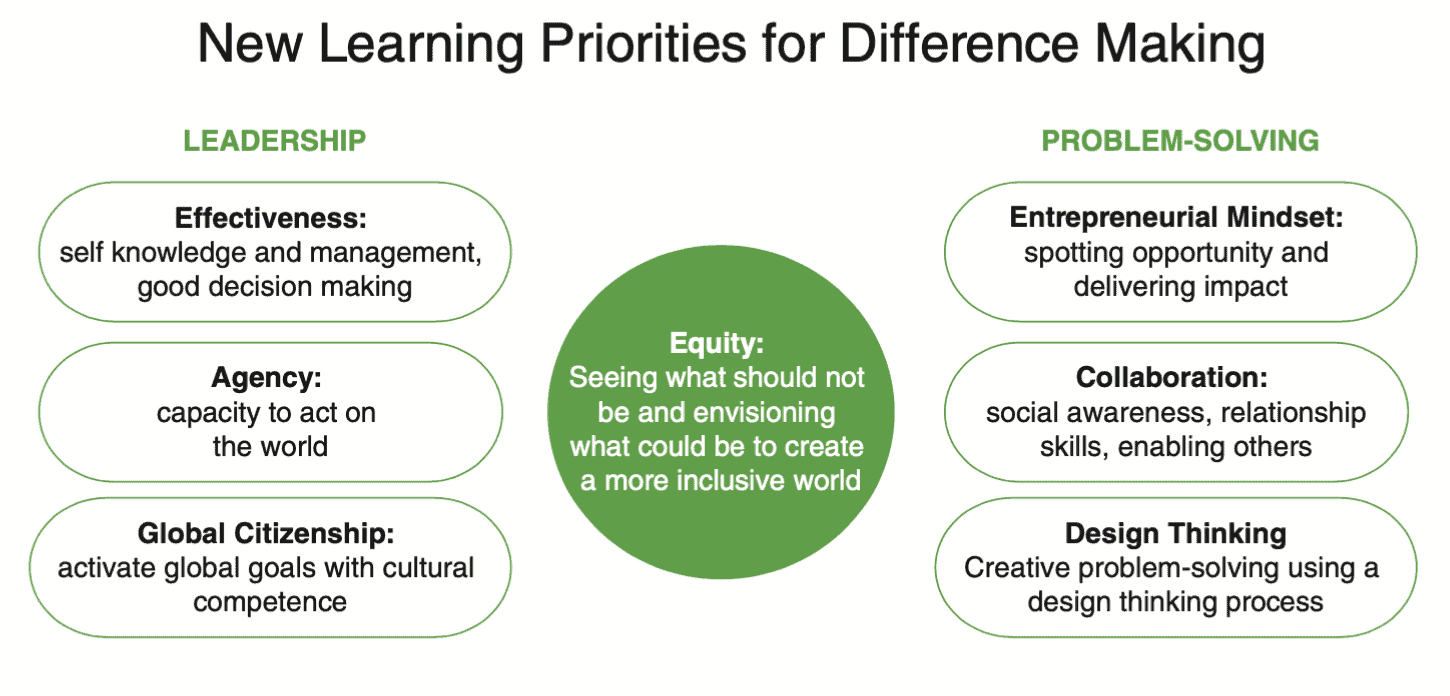Five Mega Trends Reshaping Global Learning

Imagine school as a series of community-connected projects and skill sprints that develop leadership, collaboration and problem solving skills. Imagine a web of supports that help you make the kind of contribution you’re capable of making.
Visit an innovative new school like Purdue Polytechnic High School in Indianapolis, and you’ll see evidence of mega trends reshaping secondary and postsecondary education—new goals, active learning, competency, integrated services, and edtech tools.
1. New Goals: There is a global reconsideration of learning goals and ‘graduate profiles’ based on the new economy (what the World Economic Forum calls the Fourth Industrial Revolution). There are lots of folks asking: What Should Graduates Know and Be Able to Do?
International advocate Aurora Institute urges “engaging our communities in the conversations around new definitions of success and what is necessary for redefining student success to include academic competencies, social-emotional competencies, skills and dispositions with a holistic focus for the whole child, a well-rounded education and the future of our communities.”
The Building Blocks for Learning from Turnaround illustrate the developmental progression that begin with conditions for development and skills of readiness and lead to curiosity, civic identity and self direction.
Purdue Polytechnic aims at XQ Learner Goals which adds ‘original thinkers’ and ‘generous collaborators’ and to foundational knowledge and literacies.
Want the most comprehensive answer? Check out the Minerva Project’s 100 foundational concepts and habits of success. Minerva is a university program that just graduated its first class of world changers. It takes a concept like critical thinking and breaks it down into about 30 specific skills and dispositions developed and assessed in seminars and community-connected projects.
Schools are beginning to join networks like Building 21 around next-gen essentials—collaboration, communication, presentation—as well as habits of success, personal development, and wayfinding.
Seth Godin said that leadership and solving interesting problems might be the two most important things to learn. Building on that summary, we identify priority skills in our new book, Difference Making at the Heart of Learning.
 2. Active Learning: There is a global trend toward combinations of personalized and project-based learning. Individualized skill building has been bolstered by adaptive and small group instruction. Extended challenges are more frequently being used to develop the personal leadership and problem solving skills valued by new outcome frameworks (#1).
2. Active Learning: There is a global trend toward combinations of personalized and project-based learning. Individualized skill building has been bolstered by adaptive and small group instruction. Extended challenges are more frequently being used to develop the personal leadership and problem solving skills valued by new outcome frameworks (#1).
Active learning is more student-centered, with a combination of directed tasks and open-ended challenges that provide more learner voice and choice. Rural learners in the Place Network use design thinking to take on community challenges.
“Active learning beats passive learning when it comes to students understanding concepts and retaining information and skills,” said Tracy Gardner, a teaching professor in chemical and biological engineering at Colorado School of Mines.
In the same department, Michael Barankin also uses a variety of blended strategies with a focus on communication in and out of the classroom. Student projects begin by reaching out to industry partners, developing a plan, forming teams, generating progress reports and delivering a final presentation.
Schools are developing more flexible and welcoming active learning environments that support individual, team and group experiences, and dynamic scheduling.
A year of remote learning during the pandemic reduced access to active learning for many students but the One Stone team pivoted to remote design labs. Schools in the New Tech Network did the same using their shared project-based platform to support remote active learning.
3. Competency: There is a global shift from seat time to ‘show what you know’ and progress on demonstrated mastery. It’s a complex shift that will take a few decades to play out as new tools, strategies and measures are developed. It’s moving most quickly around dynamic job clusters where an academic pedigree matters less that what you can do.
Lumina Foundation sees “competencies as currencies” and advocates hiring focused on skills rather than degrees. TechHire is a national network promoting skill-based hiring.
Badges can be a better way of organizing units of learning and measuring and communicating capabilities than time-based courses. An early leader in creating badges, IBM has issued over a million credentials to learners within and outside the company. Online learning leader Southern New Hampshire University acquired youth badging platform LRNG to extend access and create new pathways to credentials, degrees, and opportunity.
Similarly, a growing number of teachers are benefiting from personalized and competency-based learning organized as a series of microcredentials. Teachers gain the ability to choose (or build) what they wish to learn and how they demonstrate their learning.
Hundreds of schools have formed the Mastery Transcript Consortium to move from a list of courses to a richer description of capabilities. Arizona State University is working on a blockchain transcript to facilitate portability—so is a startup supporting Dallas high schools.
4. Integrated Supports: Toni Barton of Relay Graduate School sees a “bright future in which students’ differences are celebrated, their unique needs are met, and the entire system is geared toward advancing students’ academic and socio-emotional growth.” In the meantime, the growth of integrated support systems is helping to make our inherited system of age cohorts work better for more students. The number of schools offering a web of youth and family services had grown in number and in evidence of importance. Many were informed by Tiered Supports outlined by Turnaround for Children.
Many higher education institutions including Georgia State and Florida State have improved completion rates with integrated supports. A systemic approach to stronger advising and student services is summarized in a toolkit from Achieving the Dream.
An emerging trend is personalized and localized guidance–advisory systems that help learners make smart decisions about what to learn next and how to step into high wage, high demand career pathways. The San Diego Workforce Partnership offers personalized and zip code specific advice to students and working adults. In November, with Cajon Valley USD, they opened Launch Pad, a middle school career awareness space where students can engage with different careers. The Launch Pad will support student clubs, career-focused electives, and conversations with adults and career coaches.
Personalized guidance will increasingly help learners identify their strengths, interests and values and help channel those into learning activities and contribution opportunities. Living in Beta is a new advisory curriculum from One Stone, a Boise innovation engine and lab school. Through a series of short activities, usually in a small group setting, the wayfinding program invites students to explore their personal values and passions and discover their purpose.
5. EdTech Tools: Schools have been integrating mobile learning technology for more than 30 years. By 2019 most US K-12 schools were wired and most learners had access to mobile devices at school. However, the quick shift to remote learning early in 2020 showed big gaps in home wi-fi access. Districts that didn’t have a learning platform adopted one and most schools supplemented it with the use of video conferencing.
This year we’ll see a continued refinement of blended (some online and some live) and hybrid (some learning at school and some at home). Around the edges, the pandemic accelerated the development of new edtech-enabled learning models including in-home nano schools, learning pods, and microschools.
The big tech trend for the decade will be accelerating use of artificial intelligence across the curriculum and in support services (stay tuned for an AI in Edu report next month).
The combination of new goals, active learning strategies, competency-based progressions, integrated services and edtech tools is boosting learner access success.
Updated from 8/19






Christopher T Cross
Tom.
Many thanks for this. I am on the board of trustees of a liberal arts college and the president and i have just agreed to share this with her leadership team and the board. The implications of this for PSE are huge!
I am also having it Tweeted from our company's site.